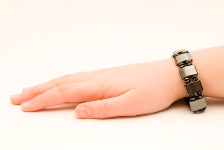 Magnet therapy burst onto the health scene in the 1990s. Study results trickled in that magnet therapy could reduce pain. Seniors, arthritis sufferers, and athletes all jumped on the bandwagon and bought magnetic bracelets, necklaces, wrist bands, and even magnetic earrings.
Magnet therapy burst onto the health scene in the 1990s. Study results trickled in that magnet therapy could reduce pain. Seniors, arthritis sufferers, and athletes all jumped on the bandwagon and bought magnetic bracelets, necklaces, wrist bands, and even magnetic earrings.
But what’s behind magnetic therapy: science or quackery? To answer that question, it’s first necessary to understand the mechanisms behind magnet therapy. What effects do magnets have on the body? Simply put, the human body responds to an applied magnetic field by producing its own magnetic field in the opposing direction. This is because the body is “diamagnetic.” Diamagnetic means weakly repelled by magnetic fields. Blood, in a similar manner to water, is weakly repelled by magnetic fields.
Does this very slight magnetic reaction create a healing effect in the body? Some magnet therapy advocates suggest that one therapeutic effect of magnets is improved blood circulation. However, there isn’t a lot of evidence to support this claim.
Others in the pro-magnet therapy camp say that nerve impulses are altered in a beneficial way when exposed to a magnetic field. There are claims that magnets increase oxygen content, exert a force on moving ions in the body and increase alkalinity of bodily fluids.
There’s also debate amongst proponents of magnet therapy about which magnetic pole is the best for treating illness. Most magnetic poles have alternating south and north poles. Other magnet therapy devices are sold with a circular pattern of poles, checkerboard patterns, and even triangular patterns. Such multipolar devices are thought to reach a larger area of the body than devices that have only a pole turned towards a patient.
So what about clinical evidence? Researchers from the University of York in the U.K. tested the effectiveness of a magnetic bracelet for reducing pain and stiffness in patients with osteoarthritis. This was a randomized double-blind placebo-controlled crossover trial. Each participant was asked to wear a magnetic wrist strap, a demagnetized wrist strap, a weak magnetic strap, and a copper bracelet.
What did the researchers find? There were no differences between the devices in terms of pain-relieving effect. However, participants did report lower sensory pain after wearing the standard magnetic wrist strap than when wearing control devices. The researchers concluded that this benefit was likely due to placebo effects and that in general, magnet therapy is ineffective.
Like most trials involving magnetic therapy, no adverse effects were reported. While the science isn’t too supportive of this unusual treatment, anecdotal evidence from a variety of people shows that it can relieve pain. Would you try magnet therapy?
Source(s) for Today’s Article:
Richmond, S.J., et al., “Therapeutic effects of magnetic and copper bracelets in osteoarthritis: a randomised placebo-controlled crossover trial,” Complement Ther Med. October-December 2009; 17(5-6): 249-56.
Barret, S., “Magnet Therapy: A Skeptical View,” Quackwatch web site; www.quackwatch.org, last accessed July 11, 2013.
Finegold, L., “Magnet Therapy,” BMJ 2006; 332: 4
